2002 MERCEDES-BENZ S600 brake
[x] Cancel search: brakePage 270 of 430
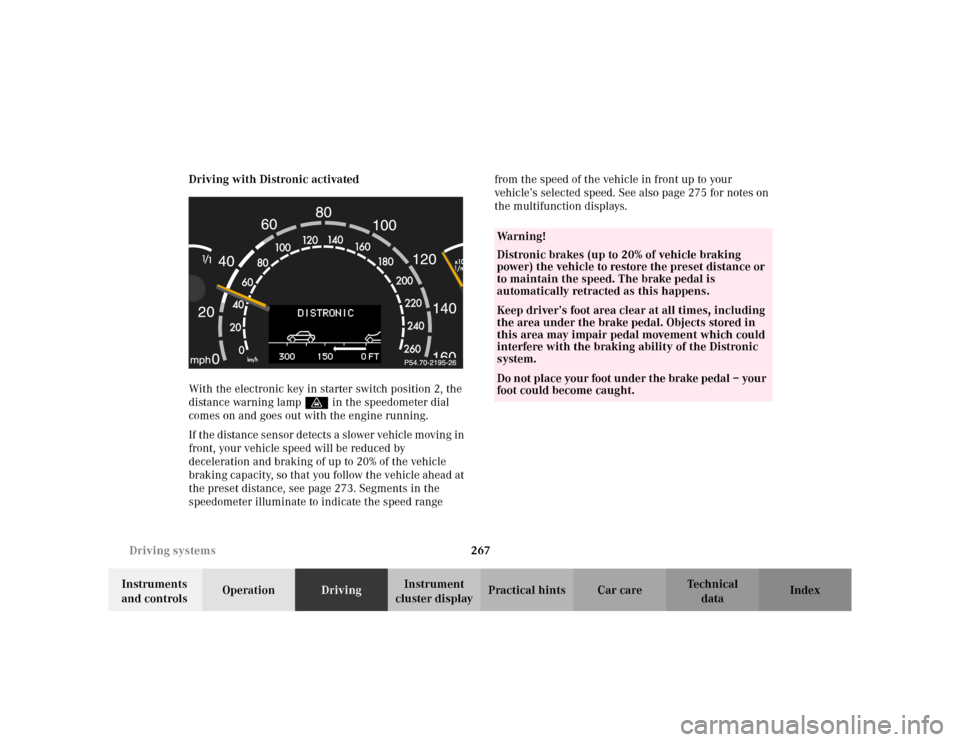
267 Driving systems
Te ch n i c a l
data Instruments
and controlsOperationDrivingInstrument
cluster displayPractical hints Car care Index Driving with Distronic activated
With the electronic key in starter switch position 2, the
distance warning lampl in the speedometer dial
comes on and goes out with the engine running.
If the distance sensor detects a slower vehicle moving in
front, your vehicle speed will be reduced by
deceleration and braking of up to 20% of the vehicle
braking capacity, so that you follow the vehicle ahead at
the preset distance, see page 273. Segments in the
speedometer illuminate to indicate the speed range from the speed of the vehicle in front up to your
vehicle’s selected speed. See also page 275 for notes on
the multifunction displays.
Wa r n i n g !
Distronic brakes (up to 20% of vehicle braking
power) the vehicle to restore the preset distance or
to maintain the speed. The brake pedal is
automatically retracted as this happens.Keep driver’s foot area clear at all times, including
the area under the brake pedal. Objects stored in
this area may impair pedal movement which could
interfere with the braking ability of the Distronic
system.Do not place your foot under the brake pedal – your
foot could become caught.
Page 271 of 430
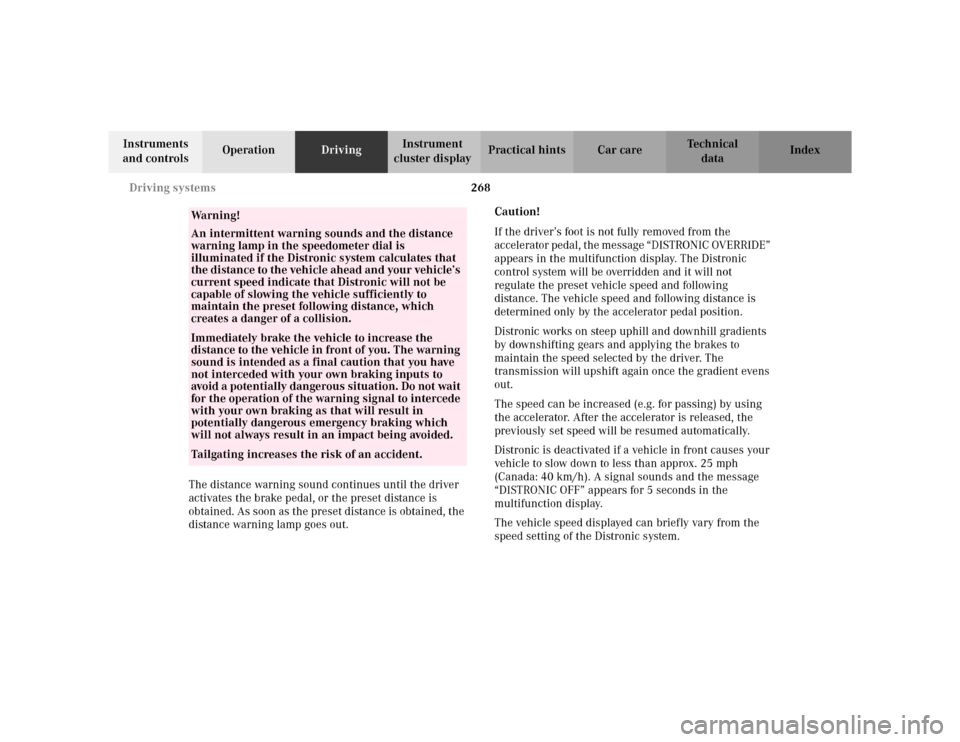
268 Driving systems
Te ch n i c a l
data Instruments
and controlsOperationDrivingInstrument
cluster displayPractical hints Car care Index
The distance warning sound continues until the driver
activates the brake pedal, or the preset distance is
obtained. As soon as the preset distance is obtained, the
distance warning lamp goes out.Caution!
If the driver’s foot is not fully removed from the
accelerator pedal, the message “DISTRONIC OVERRIDE”
appears in the multifunction display. The Distronic
control system will be overridden and it will not
regulate the preset vehicle speed and following
distance. The vehicle speed and following distance is
determined only by the accelerator pedal position.
Distronic works on steep uphill and downhill gradients
by downshifting gears and applying the brakes to
maintain the speed selected by the driver. The
transmission will upshift again once the gradient evens
out.
The speed can be increased (e.g. for passing) by using
the accelerator. After the accelerator is released, the
previously set speed will be resumed automatically.
Distronic is deactivated if a vehicle in front causes your
vehicle to slow down to less than approx. 25 mph
(Canada: 40 km/h). A signal sounds and the message
“DISTRONIC OFF” appears for 5 seconds in the
multifunction display.
The vehicle speed displayed can briefly vary from the
speed setting of the Distronic system.
Wa r n i n g !
An intermittent warning sounds and the distance
warning lamp in the speedometer dial is
illuminated if the Distronic system calculates that
the distance to the vehicle ahead and your vehicle’s
current speed indicate that Distronic will not be
capable of slowing the vehicle sufficiently to
maintain the preset following distance, which
creates a danger of a collision.Immediately brake the vehicle to increase the
distance to the vehicle in front of you. The warning
sound is intended as a final caution that you have
not interceded with your own braking inputs to
avoid a potentially dangerous situation. Do not wait
for the operation of the warning signal to intercede
with your own braking as that will result in
potentially dangerous emergency braking which
will not always result in an impact being avoided.Tailgating increases the risk of an accident.
Page 273 of 430
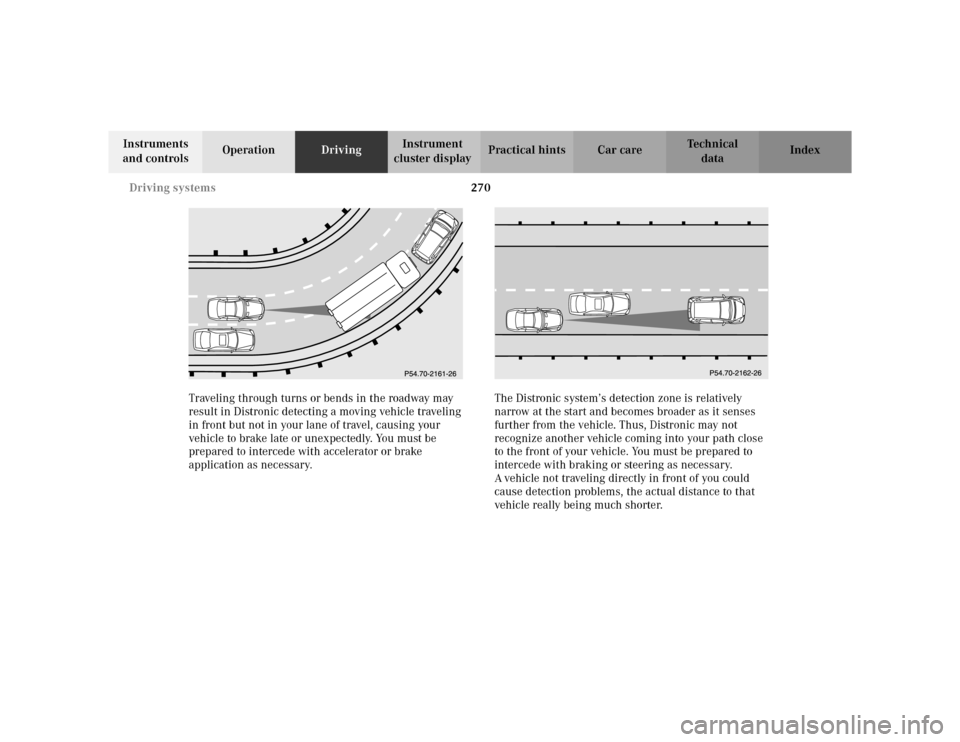
270 Driving systems
Te ch n i c a l
data Instruments
and controlsOperationDrivingInstrument
cluster displayPractical hints Car care Index
Traveling through turns or bends in the roadway may
result in Distronic detecting a moving vehicle traveling
in front but not in your lane of travel, causing your
vehicle to brake late or unexpectedly. You must be
prepared to intercede with accelerator or brake
application as necessary.The Distronic system’s detection zone is relatively
narrow at the start and becomes broader as it senses
further from the vehicle. Thus, Distronic may not
recognize another vehicle coming into your path close
to the front of your vehicle. You must be prepared to
intercede with braking or steering as necessary.
A vehicle not traveling directly in front of you could
cause detection problems, the actual distance to that
vehicle really being much shorter.
Page 274 of 430
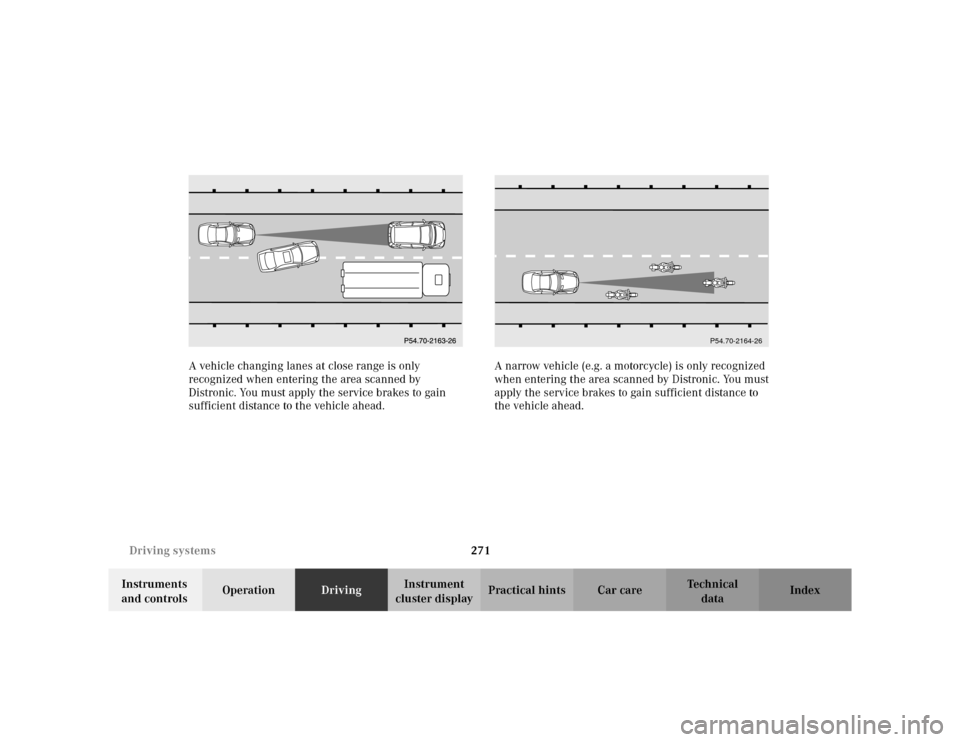
271 Driving systems
Te ch n i c a l
data Instruments
and controlsOperationDrivingInstrument
cluster displayPractical hints Car care Index A vehicle changing lanes at close range is only
recognized when entering the area scanned by
Distronic. You must apply the service brakes to gain
sufficient distance to the vehicle ahead.A narrow vehicle (e.g. a motorcycle) is only recognized
when entering the area scanned by Distronic. You must
apply the service brakes to gain sufficient distance to
the vehicle ahead.
P54.70-2164-26
Page 275 of 430
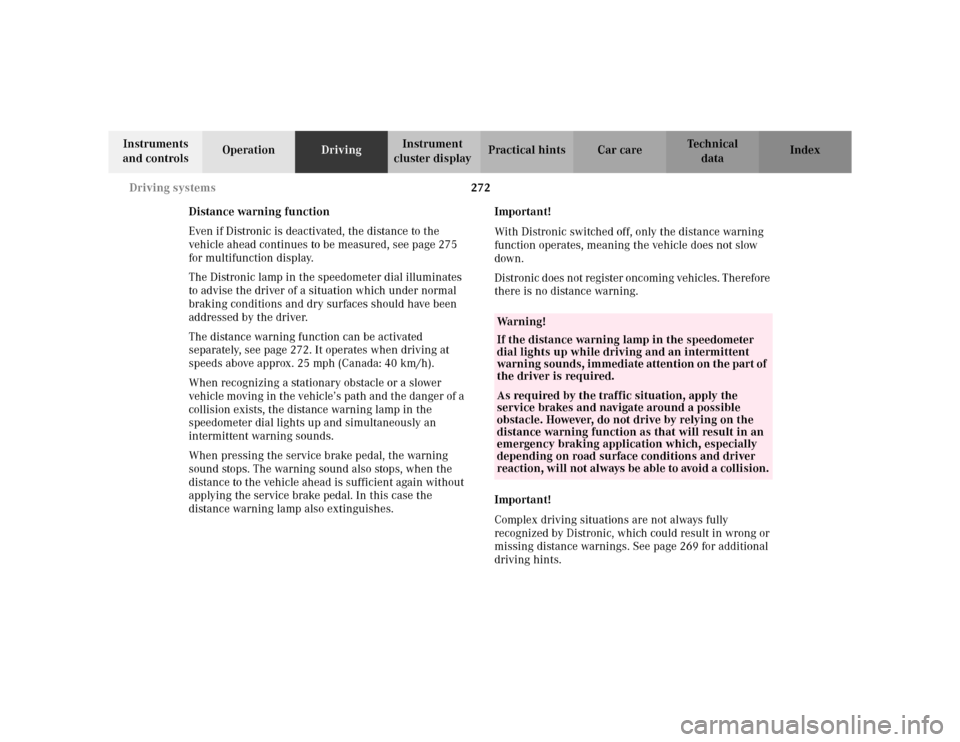
272 Driving systems
Te ch n i c a l
data Instruments
and controlsOperationDrivingInstrument
cluster displayPractical hints Car care Index
Distance warning function
Even if Distronic is deactivated, the distance to the
vehicle ahead continues to be measured, see page 275
for multifunction display.
The Distronic lamp in the speedometer dial illuminates
to advise the driver of a situation which under normal
braking conditions and dry surfaces should have been
addressed by the driver.
The distance warning function can be activated
separately, see page 272. It operates when driving at
speeds above approx. 25 mph (Canada: 40 km/h).
When recognizing a stationary obstacle or a slower
vehicle moving in the vehicle’s path and the danger of a
collision exists, the distance warning lamp in the
speedometer dial lights up and simultaneously an
intermittent warning sounds.
When pressing the service brake pedal, the warning
sound stops. The warning sound also stops, when the
distance to the vehicle ahead is sufficient again without
applying the service brake pedal. In this case the
distance warning lamp also extinguishes.Important!
With Distronic switched off, only the distance warning
function operates, meaning the vehicle does not slow
down.
Distronic does not register oncoming vehicles. Therefore
there is no distance warning.
Important!
Complex driving situations are not always fully
recognized by Distronic, which could result in wrong or
missing distance warnings. See page 269 for additional
driving hints.
Wa r n i n g !
If the distance warning lamp in the speedometer
dial lights up while driving and an intermittent
warning sounds, immediate attention on the part of
the driver is required.As required by the traffic situation, apply the
service brakes and navigate around a possible
obstacle. However, do not drive by relying on the
distance warning function as that will result in an
emergency braking application which, especially
depending on road surface conditions and driver
reaction, will not always be able to avoid a collision.
Page 280 of 430
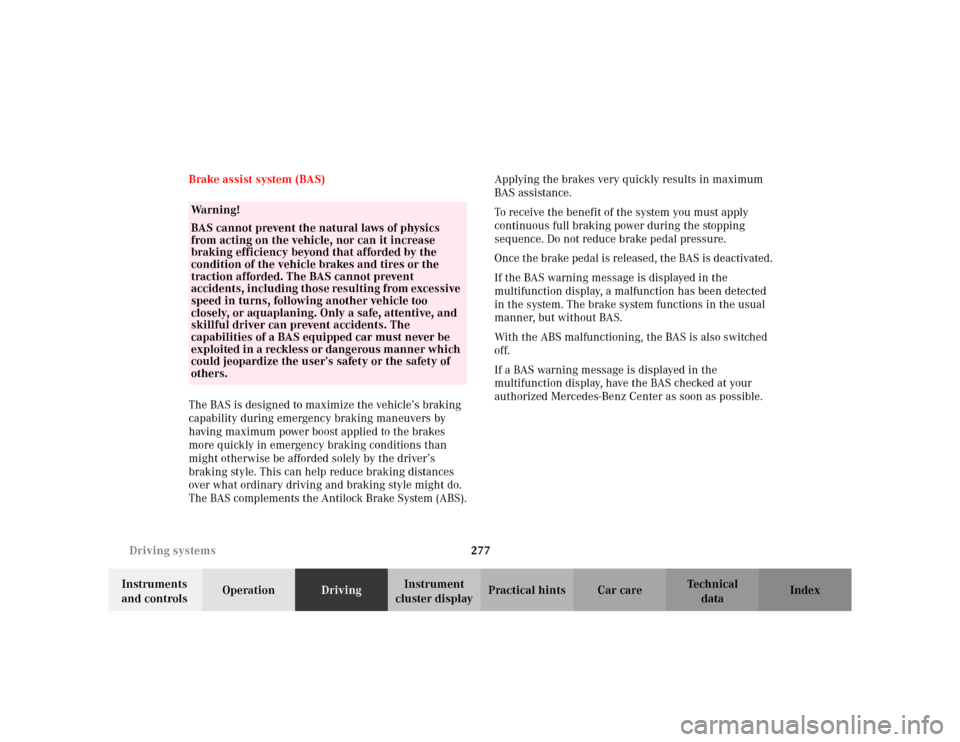
277 Driving systems
Te ch n i c a l
data Instruments
and controlsOperationDrivingInstrument
cluster displayPractical hints Car care Index Brake assist system (BAS)
The BAS is designed to maximize the vehicle’s braking
capability during emergency braking maneuvers by
having maximum power boost applied to the brakes
more quickly in emergency braking conditions than
might otherwise be afforded solely by the driver’s
braking style. This can help reduce braking distances
over what ordinary driving and braking style might do.
The BAS complements the Antilock Brake System (ABS).Applying the brakes very quickly results in maximum
BAS assistance.
To receive the benefit of the system you must apply
continuous full braking power during the stopping
sequence. Do not reduce brake pedal pressure.
Once the brake pedal is released, the BAS is deactivated.
If the BAS warning message is displayed in the
multifunction display, a malfunction has been detected
in the system. The brake system functions in the usual
manner, but without BAS.
With the ABS malfunctioning, the BAS is also switched
off.
If a BAS warning message is displayed in the
multifunction display, have the BAS checked at your
authorized Mercedes-Benz Center as soon as possible.
Wa r n i n g !
BAS cannot prevent the natural laws of physics
from acting on the vehicle, nor can it increase
braking efficiency beyond that afforded by the
condition of the vehicle brakes and tires or the
traction afforded. The BAS cannot prevent
accidents, including those resulting from excessive
speed in turns, following another vehicle too
closely, or aquaplaning. Only a safe, attentive, and
skillful driver can prevent accidents. The
capabilities of a BAS equipped car must never be
exploited in a reckless or dangerous manner which
could jeopardize the user’s safety or the safety of
others.
Page 281 of 430
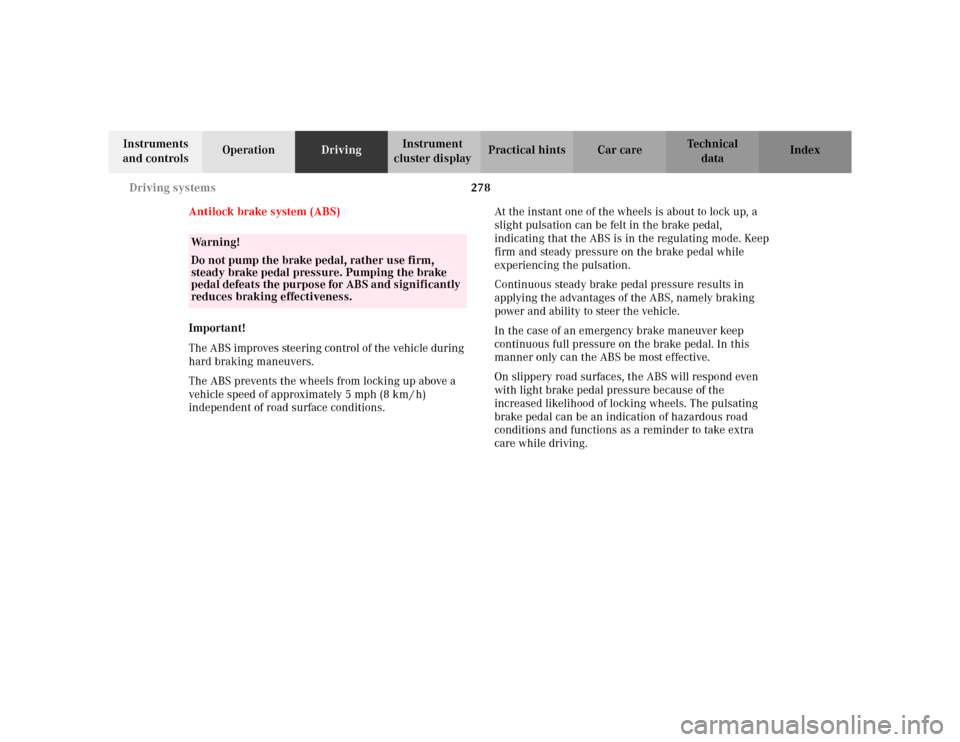
278 Driving systems
Te ch n i c a l
data Instruments
and controlsOperationDrivingInstrument
cluster displayPractical hints Car care Index
Antilock brake system (ABS)
Important!
The ABS improves steering control of the vehicle during
hard braking maneuvers.
The ABS prevents the wheels from locking up above a
vehicle speed of approximately 5 mph (8 km / h)
independent of road surface conditions.At the instant one of the wheels is about to lock up, a
slight pulsation can be felt in the brake pedal,
indicating that the ABS is in the regulating mode. Keep
firm and steady pressure on the brake pedal while
experiencing the pulsation.
Continuous steady brake pedal pressure results in
applying the advantages of the ABS, namely braking
power and ability to steer the vehicle.
In the case of an emergency brake maneuver keep
continuous full pressure on the brake pedal. In this
manner only can the ABS be most effective.
On slippery road surfaces, the ABS will respond even
with light brake pedal pressure because of the
increased likelihood of locking wheels. The pulsating
brake pedal can be an indication of hazardous road
conditions and functions as a reminder to take extra
care while driving.
Wa r n i n g !
Do not pump the brake pedal, rather use firm,
steady brake pedal pressure. Pumping the brake
pedal defeats the purpose for ABS and significantly
reduces braking effectiveness.
Page 282 of 430
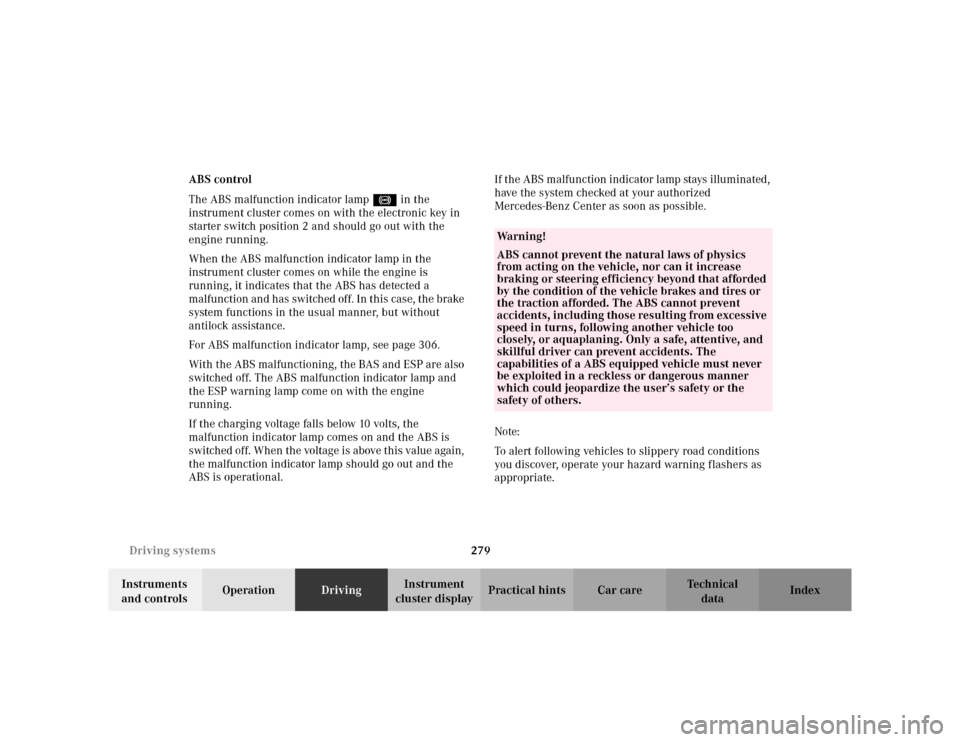
279 Driving systems
Te ch n i c a l
data Instruments
and controlsOperationDrivingInstrument
cluster displayPractical hints Car care Index ABS control
The ABS malfunction indicator lamp- in the
instrument cluster comes on with the electronic key in
starter switch position 2 and should go out with the
engine running.
When the ABS malfunction indicator lamp in the
instrument cluster comes on while the engine is
running, it indicates that the ABS has detected a
malfunction and has switched off. In this case, the brake
system functions in the usual manner, but without
antilock assistance.
For ABS malfunction indicator lamp, see page 306.
With the ABS malfunctioning, the BAS and ESP are also
switched off. The ABS malfunction indicator lamp and
the ESP warning lamp come on with the engine
running.
If the charging voltage falls below 10 volts, the
malfunction indicator lamp comes on and the ABS is
switched off. When the voltage is above this value again,
the malfunction indicator lamp should go out and the
ABS is operational.If the ABS malfunction indicator lamp stays illuminated,
have the system checked at your authorized
Mercedes-Benz Center as soon as possible.
Note:
To alert following vehicles to slippery road conditions
you discover, operate your hazard warning flashers as
appropriate.
Wa r n i n g !
ABS cannot prevent the natural laws of physics
from acting on the vehicle, nor can it increase
braking or steering efficiency beyond that afforded
by the condition of the vehicle brakes and tires or
the traction afforded. The ABS cannot prevent
accidents, including those resulting from excessive
speed in turns, following another vehicle too
closely, or aquaplaning. Only a safe, attentive, and
skillful driver can prevent accidents. The
capabilities of a ABS equipped vehicle must never
be exploited in a reckless or dangerous manner
which could jeopardize the user’s safety or the
safety of others.